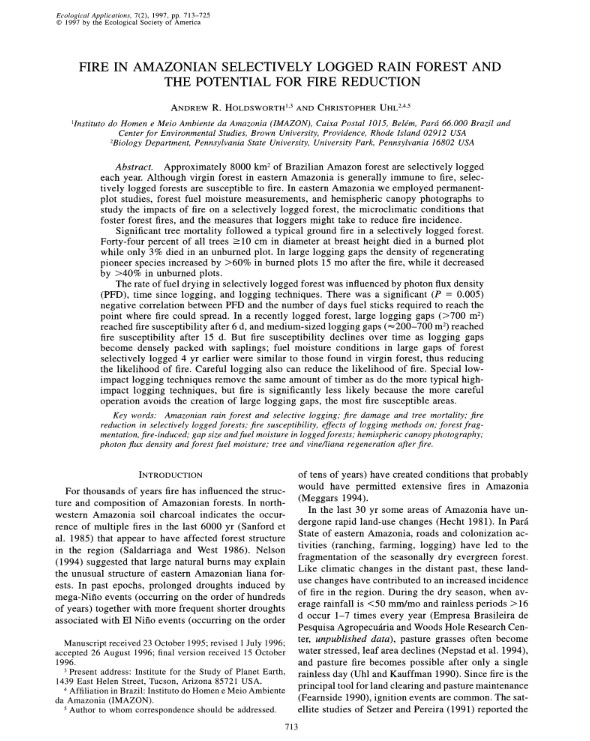

| Título | Fire in Amazonian selectively-logged rain forest and the potential for fire reduction |
| Autores | Andrew R. Holdsworth Christopher Uhl |
| Ano de publicação | 1997 |
| DOI | https://doi.org/10.1890/1051-0761(1997)007[0713:FIASLR]2.0.CO;2 |
HOLDSWORTH, A.; UHL, C. Fire in Amazonian selectively logged rain forest and the potential for fire reduction. Ecological Applications, v. 7, n. 2, p. 713-725, 1997.
Approximately 8000 km2 of Brazilian Amazon forest are selectively logged each year. Although virgin forest in eastern Amazonia is generally immune to fire, selectively logged forests are susceptible to fire. In eastern Amazonia we employed permanent-plot studies, forest fuel moisture measurements, and hemispheric canopy photographs to study the impacts of fire on a selectively logged forest, the microclimatic conditions that foster forest fires, and the measures that loggers might take to reduce fire incidence.
Significant tree mortality followed a typical ground fire in a selectively logged forest. Forty-four percent of all trees ≥10 cm in diameter at breast height died in a burned plot while only 3% died in an unburned plot. In large logging gaps the density of regenerating pioneer species increased by >60% in burned plots 15 mo after the fire, while it decreased by >40% in unburned plots.
The rate of fuel drying in selectively logged forest was influenced by photon flux density (PFD), time since logging, and logging techniques. There was a significant (P = 0.005) negative correlation between PFD and the number of days fuel sticks required to reach the point where fire could spread. In a recently logged forest, large logging gaps (>700 m2) reached fire susceptibility after 6 d, and medium-sized logging gaps (≈200–700 m2) reached fire susceptibility after 15 d. But fire susceptibility declines over time as logging gaps become densely packed with saplings; fuel moisture conditions in large gaps of forest selectively logged 4 yr earlier were similar to those found in virgin forest, thus reducing the likelihood of fire. Careful logging also can reduce the likelihood of fire. Special low-impact logging techniques remove the same amount of timber as do the more typical high-impact logging techniques, but fire is significantly less likely because the more careful operation avoids the creation of large logging gaps, the most fire susceptible areas.
This post was published on 5 de junho de 1997
Amorim, L., Ferreira, R., Dias, M., Souza Jr., C., & Veríssimo, A. Sistema de Alerta…
Título Índice de Progresso Social Brasil 2025 Autores Melissa Wilm Daniel Santos Beto Veríssimo Marcelo…
Amorim, L., Ferreira, R., Dias, M., Souza Jr., C., & Veríssimo, A. Sistema de Alerta…
Título Relatório Anual do Desmatamento no Brasil - RAD2024 Autores Carolina Del Lama Julia Shimbo…
Título Fatos da Amazônia 2025 Autores Daniel Santos Manuele Lima Agatha Vilhena Beto Veríssimo Caíque…
Amorim, L., Ferreira, R., Dias, M., Souza Jr., C., & Veríssimo, A. Sistema de Alerta…